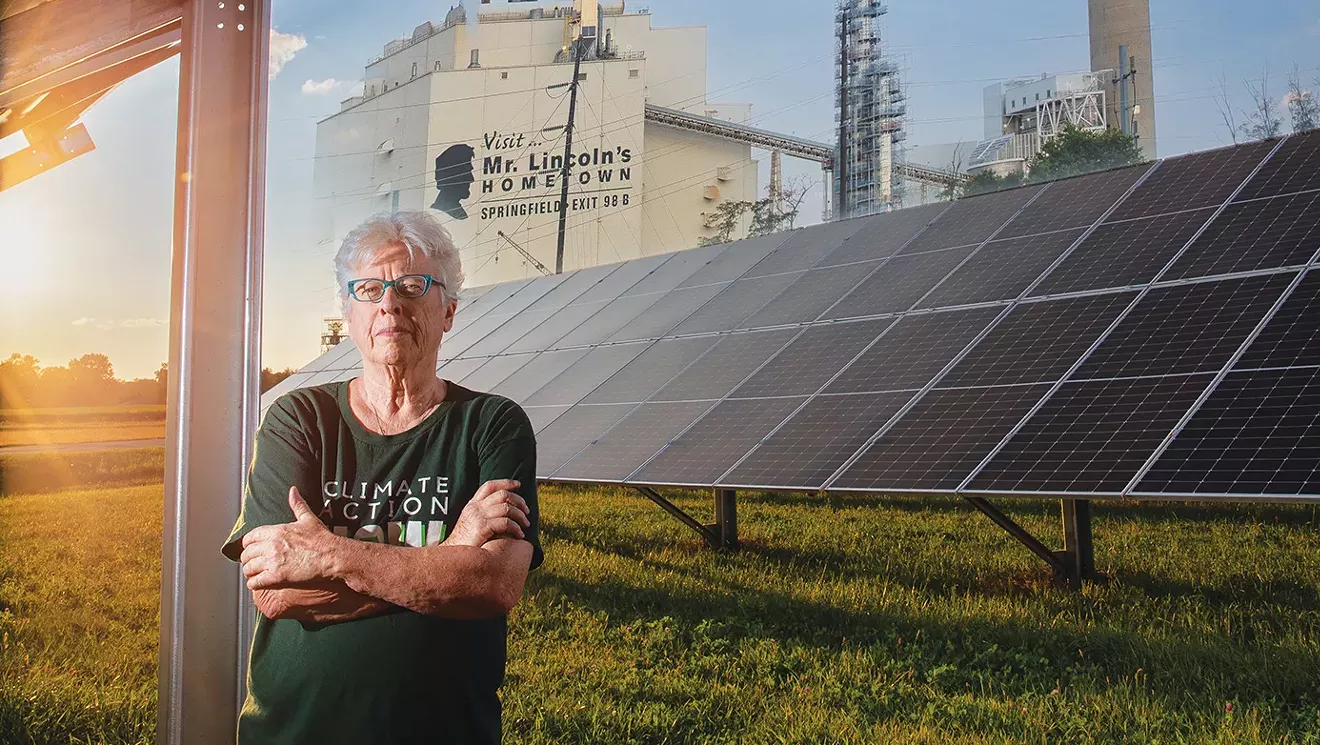
PHOTO BY MARIA ANSLEY
Anne Logue, a member of the local energy activism group Sustainable Springfield, has previously addressed the Springfield City Council to request more input from citizens on the operations of CWLP. The municipal utility has agreed to create a new Integrated Resource Plan to address recent changes in environmental regulations.
Last month, the Springfield City Council approved CWLP’s proposal for a new solar contract. CWLP will enter into a 25-year agreement with Sangamon Solar to spend $13 million to purchase 25 megawatts of energy and capacity, with plans to utilize a new 100-megawatt, 750-acre solar installation to be built to the south of Chatham. The installation is expected to begin construction next year with operation starting in 2028. It will also potentially create “a number of local construction and maintenance jobs,” according to a press release from CWLP.
“Adding more solar resources for CWLP is a goal I’ve had since taking office,” said Springfield Mayor Misty Buscher, in the same press release. “I like that Springfield can have diverse energy options to serve our citizens and that we have this installation being local to CWLP’s transmission lines, which is great for the city.”
One way increased solar energy will benefit local consumers is through a $100,000 Community Solar Energy Sovereignty grant awarded to the city by the state’s Department of Commerce & Economic Opportunity (DCEO) in late 2024, which will provide opportunities for financial help to low-income community members through its Sunshine Savings program. Tom Chi, projects manager for Springfield’s Smart Cities program, explained that the grant will be used to help residents who may be behind on their utility bills.
“What I am envisioning is supplementing Low Income Home Energy Assistance Program (LIHEAP) funds once it runs out or an application process similar to that,” Chi said.
According to a statement on CWLP’s website, the power company’s upcoming budget for fiscal year 2026 will include funding to start a new Integrated Resource Plan to address recent changes in environmental regulations. An IRP, among other factors, provides an opportunity for a group of citizens with specialized knowledge and safety concerns to weigh in on the way their utilities are run.
“I have heard that (CWLP employees) are way too busy just doing their jobs to research these things and too tied to fossil fuels to examine other options,” said Anne Logue, a member of the local energy activism group Sustainable Springfield. “You can’t really blame people for being too busy. But at the same time, essential things are being overlooked.”
According to Logue, the rise of artificial intelligence has emerged as a vital threat to the goal of reducing greenhouse gas emissions. While Springfield doesn’t currently have any large AI industry users, the proliferation of it in other markets makes it a high-priority suggestion for the next IRP.
“AI services are taking dominance over our electricity generation,” Logue said, explaining that in addition to driving up consumer costs, AI itself requires so much energy that host utilities end up looking to outside sources to meet these requirements, often resulting in expensive and unpredictable pricing.
There is a solution for this problem available to a city utility, according to Logue. “They can stipulate that for the AI company to use their utility, the company must provide their own backup battery storage systems to avoid power shortages during peak hours when AI can rely on their own stored energy.”
In the press release announcing the new solar contract, CWLP Chief Utility Engineer Doug Brown said that “solar is a good fit to our portfolio and securing this contract at a good price is the right thing for our customers by further reducing some of our market purchase exposure to higher costs.”
Tom Chi also mentioned additional goals including “identifying and assessing potential solar installation sites with environmental and technical feasibility studies, engaging the community with targeted outreach efforts, creating a detailed financial model that outlines the method for distributing generated revenue directly in the form of bill credits and also creating a governance structure that will establish clearly defined roles and responsibilities.”
Logue pointed out that while the 25-megawatt solar farm power purchase agreement is a notable investment, it still represents just 6.5% of the state’s 40% renewable portfolio target for 2040. “We hope that the upcoming IRP process can carve a path to how we are going to get to that 40%,” she said.


